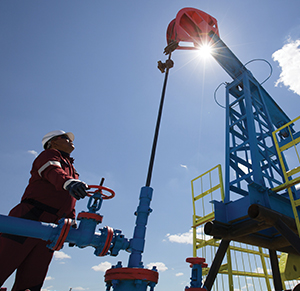Since 2002, Kazakhstan has en-joyed strong economic development, with the World Bank report-ing a sixfold increase in gross domestic product (GDP) in this time to $159.4bn in 2017. However, this pales in comparison to 2013’s GDP of $236.6bn, before the drop in oil prices hit the economy.
Kazakhstan witnessed economic growth of 4.1% in the first half of 2018, on the back of its oil production, which grew by 6.2% when compared with the same period of 2017. Both the service sector and agriculture also grew, although infrastructure was flat. However, having learned how essential diversification is, Kazakhstan is now broadening its focus.
International interest
Kazakhstan considers itself as ideally placed for international growth, bordering China on its east side, Russia on its north and west, while also being close to eastern Europe. While the country’s main export partners are China ($4.3bn) and Russia ($3.75bn), it sees potential in looking further than its immediate borders.
Trade with the EU has the potential to grow. A provisional enhanced partnership and co-operation agreement between the two was signed in May 2016, and the EU Strategy for Central Asia is being revised and planned for completion in 2019.
Kazakhstan is also keen to increase foreign direct investment (FDI). It has seen a sharp rise in FDI, although this was offset by short-term capital outflows, causing international reserves to decline by 2% in the first half of 2018, compared with the same period the previous year.
Saparbek Tuyakbayev, chairman at investment promotion agency Kazakh Invest, says: “The main issues for international investors is gaining access to the markets. The approach has changed over the past 10 years as the importance of access grew. The greater level of integration into the EU has provided access to a 180 million population [and] access to the EU also benefits the rest of the central Asian countries.”
Proactive steps have been taken to create an environment to encourage greater overseas investment. The Astana International Financial Centre (AIFC) was established in July 2018 to create an international free-trade area in the country, and given dispensation by the Kazakh government to operate under English law and arbitration to settle disputes. Both of these are outside of the Kazakh judicial system.
Mr Tuyakbayev says: “The country wants to position itself as a good alternative investment market. The legislation has been reformed within the AIFC to be in line with English law, making it more accessible to international investors. Kazakhstan wants to be seen as a safe place, where the rights of the investor are protected.”
The AIFC also has the objectives to create a regulatory regime based on the best international standards, and focus on green finance developments with support for the issuance of green bonds.
Oil money
Kazakhstan aims to be among the top 30 global economies under its Strategy 2050. Established in 2012, the policy will see the country undertake a series of economic, social and political reforms. The oil and gas sector is the area attracting the most attention, and has the greatest potential for profits.
During 2018, Kazakhstan became self-sufficient in its production of oil and gas, as the Kashagan oil field produced higher than expected levels. The country has big ambitions for exporting oil and gas far beyond its borders, but as a landlocked country its pipelines need significant investment to make this viable.
Bolat Akchulakov, Kazakhstan’s vice-minister of energy, says: “Infrastructure for the export of goods is of significant importance. There is the Caspian Pipeline Consortium with capacity of more than 60 million tonnes of crude annually, and the Russian system Transneft, which will link our supply to Europe via Russia. There is also the pipeline to China, and a focus on the development of the pipeline from the Caspian Sea. Eastern European countries, such as Romania and Georgia, are also strong potential export markets.”
Kazakhstan is still keen to explore the prospect of further oil discoveries, but recognises there has to be more financing to do this. To make it easier for international businesses to participate, legislative changes have been made to enable the granting of use rights to oil and gas – either through auction, or negotiation with the national company in the proposed area.
Mr Akchulakov says: “There is a need to attract more investment for further oil and gas exploration. Kazakhstan has made significant amendments to subsoil legislation. The new subsoil code and amendments to the tax code have been implemented in 2018. Such legislation changes provide additional possibilities to potential investors to participate in hydrocarbon exploration and production.”
Environmental obligations
But as investors are looking to greener investments, the country faces the challenge of switching to environmentally friendly energy production. “We have signed the Paris Agreement and take the obligation seriously,” says Mr Akchulakov. “We have a target of producing up to 3% of all energy from green or renewable sources by 2020. There are already hydropower facilities in the country, but we are looking to expand into solar, wind and biomass.”
The decision to look at renewable sources is also influenced by the desire to attract a wider selection of prospective investors, but more developments are needed to make it a viable option.
Mr Akchulakov says: “There has been the influence of investors who are looking for renewables. There is a need to mitigate the risk from currency fluctuations, as renewables can be expensive. There needs to be greater focus on the development of technology to make renewables cheaper in the future.”
In October 2018, Kazakhstan held a solar auction, attracting 28 bids from 20 companies. In the first in a series of renewables auctions, four companies were granted a share of 170 megawatts. In total 1 gigawatt of renewable energy will be allocated across the forthcoming auctions covering solar, wind, hydro and biomass projects.
Further exploration into energy production methods could also be a possibility, especially if it makes use of the country’s other abundant natural resources. Mr Akchulakov says: “The country does not have any nuclear power capacity. There is still a lot of concern around it, but being the largest producer and supplier of uranium in the world, we are thinking about possibilities of developing our own nuclear power generation capacities.”
Diversify and expand
As Kazakhstan discovered when the price of oil plunged in 2014, over-dependence on one industry can have a huge human cost when the market turns. World Bank figures show the country is still growing out of poverty, with the greatest impact on its southern region. The poverty rate rose in 2016, from 5.6% of the population to 7.7% (using the $5.50 a day poverty line). In the following years the numbers have dropped again, to 5.9% in 2018. In 2017 a sharp fall in oil prices once again put pressure on the country but since then the market has seen recovery and an improvement in poverty levels.
Taking advantage of its geographic size, Kazakhstan is looking into expanding its agricultural output. About 74% of land is suitable for agricultural production, and it is one of the world’s top 10 grain producers, with 2017 production estimated at 13 million tonnes.
Mr Tuyakbayev says: “Food and agriculture is expected to be a significant growth market. There is a population of 500 million people in the countries around the border of Kazakhstan. The country also has significant deposits of rare earths such as lithium and cobalt needed in the production of smartphones and electric cars.”
It is the abundance of these rare earths, and their growing use in modern technology, that could lure Kazakhstan away from its dependence on fossil fuels and open up other markets. “Kazakhstan has to look towards the manufacturing space, but it cannot compete with China and the US for cheap materials,” says Mr Tuyakbayev. “Instead, it can produce based on its own strengths. Solar panels are a possibility as the country is rich in uranium deposits needed for their manufacture. Keeping key production close reduces the cost.”
Corporate privatisation
Kazakhstan is undergoing a privatisation drive as part of a government economic policy. Of the 867 companies included, 200 are assets of government-owned Samruk-Kazyna (also referred to as the National Welfare Fund). Founded in 2008, Samruk-Kazyna, a sovereign wealth fund and joint-stock company with interests in some of the country’s largest companies, today has assets of $78bn. CEO Akhmetzhan Yessimov says the fund aims to reduce the influence of state regulation on the economy and bring the country in line with Organisation for Economic Co-operation and Development countries, with the government not having input in more than 15% of businesses.
In order to make the assets attractive options to potential investors, groundwork is being done to bring a diverse portfolio up to international standards. Mr Yessimov says: “Six major assets of the fund – Kazatomprom, Air Astana, Kazakhtelecom, KazMunayGas, Kazpost and Kazakhstan TemirZholy – are planned for an initial public offering [IPO] between 2018 and 2020. Currently the companies are executing internal preparations to improve operational efficiency and determine the best outline for a probable IPO.”
Mr Yessimov says the goal of the portfolio is to give it scope for future developments in the Kazakh economy. “An optimal and diversified portfolio structure will allow the fund, in the long term, to reduce portfolio volatility, increase income sustainability, ensure new investment opportunities and avoid concentration risks,” he adds.
This does not mean they have strict operational boundaries, however. “The fund will not set investment limits by industry, asset classes or investment geography. As the owner of assets, the fund reserves the right to balance the portfolio and have full flexibility in changing it, based on the market situation, or opportunities for portfolio growth,” says Mr Yessimov.
As Kazakhstan position itself to rub shoulders with the world’s biggest economies, no options are off the table.













